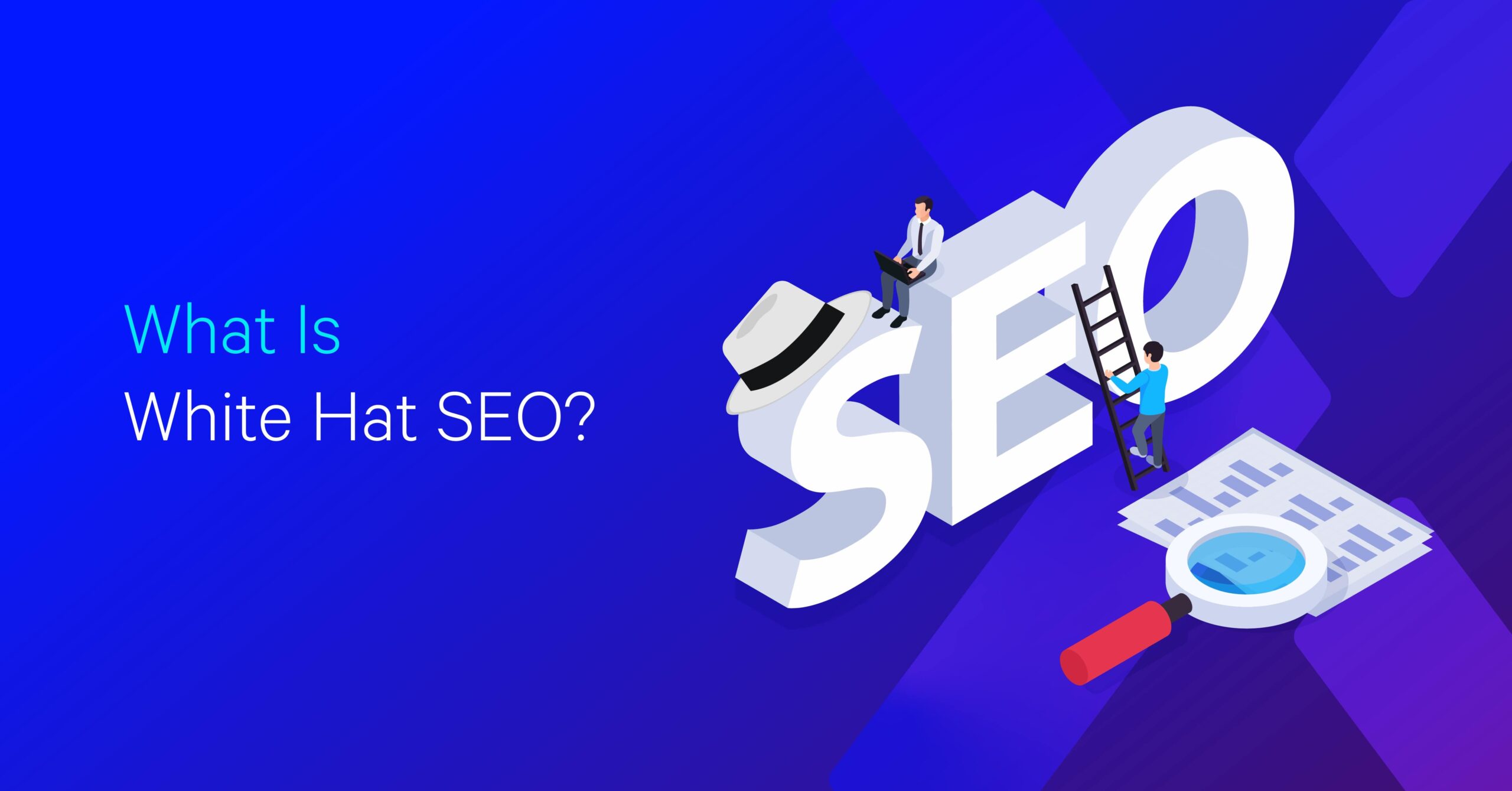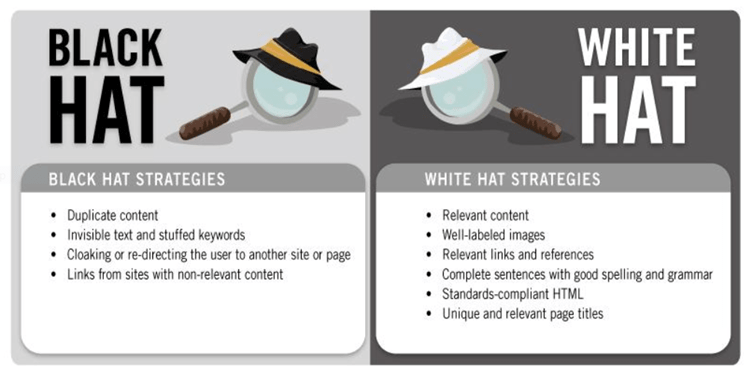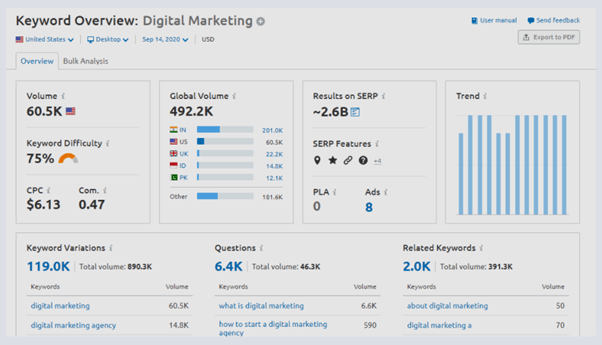What Is White Hat SEO?

Hand off the toughest tasks in SEO, PPC, and content without compromising quality
Explore ServicesSearch engine optimization (SEO) has been cited by digital marketers as the most effective content marketing tactic they’ve used. Having a strong SEO strategy is critical for your overall digital marketing strategy.
Like cowboys wearing white and black hats to distinguish the “good guys” from the “bad guys,” “white hat SEO” and “black hat SEO” denote good and bad SEO practices, respectively.
Although both white hat SEO and black hat SEO have the same goal in mind, there are some key differences you should be aware of, especially since some black hat SEO tactics may result in a Google penalty. Black hat SEO is associated with searching for and exploiting loopholes in the Google search algorithm.
This article will look at what white hat SEO is, how it differs from black hat SEO, the fundamentals of white hat SEO tactics, and how they can improve key ranking factors.
Let’s dive in!
What Is White Hat SEO?
White hat SEO refers to SEO strategies that work within the rules and expectations of search engines and searchers. It entails employing techniques to improve a website’s search engine ranking without relying on tricks to destabilize a search engine’s algorithm.
Instead of using more spammy techniques, such as duplicate content that is only optimized for search engines, white hat SEO strategies focus on providing readers with high-quality and relevant content that optimizes user experience.
White hat SEO examples include:
- Mobile-friendliness and fast site loading times
- Providing high-quality content and services
- Making your website easy to use
- Using keyword-rich, descriptive meta tags.

Why Is White Hat SEO Important?
White hat SEO has several benefits:
Less Costly: In the long run, white hat SEO is less expensive than black hat SEO because it does not require the repair of Google-identified and penalized violations. A common example is the time-consuming manual removal of spam links from blog comments or forums.
Consistency: Rankings are typically more stable and, in particular, long-term when compared to pages optimized through unethical means, which may result in penalties. According to statistics, the #1 organic search result on Google has a CTR of 31.7 percent on average.
Security: Sites that use white hat SEO are safe from Google penalties. As a result, the Damocles sword of sales failures caused by a penalty does not hang over the website all the time.
Produces high-quality content: Everything you do should be done with the goal of providing a positive customer experience. Users recognize high-quality content and will eventually reward you for it. As a result, a page ranked #1 organically is 10 times more likely to receive a click than a page ranked #10.
Ethics: For ethical reasons, entrepreneurs use white hat SEO to justify their position in the SERPs to their visitors.
What are some White Hat SEO examples?
Here are some examples to ensure that your SEO methods are completely white hat.
- Provide high-quality content and services
Create high-quality content that meets your visitors’ needs and assists them in resolving their issues. Use SEO keyword research tools to identify the most relevant keywords for which your website’s content should be optimized.
Then, focus on incorporating those keywords into great relevant content, such as how-to articles and videos, that correspond to the keyword’s intent and your end-user.
Using SEO tools like Google Keyword Planner and SEMrush to define the best keywords is a good idea. They allow you to search for and compare the relevance of each keyword across multiple search engines.
 Authoritative inbound links
Authoritative inbound links
As opposed to paid links, inbound links have become one of the most important components of your SEO efforts. Obtaining authoritative inbound links takes time and dedication, but the benefits of improved SERP rankings and increased overall site organic traffic make it well worth the effort.
You can use white hat link building services or you can earn links through:
- guest posting
- blogging
- reviews
- interviews
- roundups
These help you increase the authority of your site with high-quality inbound links. The key here is to cultivate relationships and reach out to bloggers and journalists to inform them about your valuable content.
Spammy comments on forums and free hosting sites are also prohibited, according to Google. The bottom line is that anyone commenting in order to gain more backlinks should make their comments valuable.

- Make your site easy to navigate
When organizing the Information Architecture of your website, keep this in mind. Sites that are easy to navigate tend to perform better in organic search results as well.
Ensure that Google can properly crawl your site and that you have an accurate sitemap with all of your important pages (upload your sitemap to Google Search Console to determine if there are any crawling difficulties.))
When designing a site structure for SEO, keep in mind not only the impact on keyword rankings but also the impact on usability and website conversions.
Fast page loading times are required because responsive sites, like simple navigation or mobile optimization, do not frustrate visitors or encourage bounce. Site speed is a search engine ranking signal in terms of SEO metrics.
Sites that take too long to respond to visitor requests for whatever reason (large images, image carousels, etc.) generally rank lower in SERPs because the user experience suffers. Consider functionality and features, as well as how they affect load times.
White Hat SEO vs Black Hat SEO
The use of Google-approved website optimization strategies, techniques, and tactics is referred to as white-hat SEO. Black hat SEO tactics, on the other hand, may increase a site’s SERP rankings but are unethical and violate search engine guidelines.
The primary distinction between these two approaches is that white hat SEO adheres to Google’s guidelines and improves user experience, whereas black hat SEO violates those guidelines and is typically performed with complete disregard for human users.
Here are some of the best white hat SEO strategies you can use to boost your website’s visibility:
- Content-relevant keywords
- Quality content
- Lean code/well-structured markup language
- Keyword-rich page titles and metadata
- Authoritative inbound links
- Fast page loading times
- Simple website navigation
However, if you use any of these, you are engaging in black hat SEO techniques.
- Taking part in link schemes
- Content that is generated automatically
- Cloaking
- Keyword stuffing
- Links or hidden text
- Doorway pages
- Sneaky redirects
- Scraped content
- Abusing rich snippets markup
- Sending Google automated queries
- Pages are being loaded with irrelevant keywords
- Making pages with little or no unique content
- Participating in affiliate programs without providing enough value
- Creating malicious-behavior pages, such as phishing or installing viruses, trojans, or other badware
White Hat SEO FAQ
Does white hat SEO work?
Definitely!
Implementing white hat SEO practices is the best way to build an ethical, long-term successful website and business.
The most significant limitation of white hat SEO is its limited scope. Of course, search engine optimizers are capable of performing extensive on-page optimization. If you don’t want to end up on the black hat SEO or grey hat SEO bandwagon, your options for off-page Optimization are very limited. In its Webmaster Guidelines, Google forbids unnatural link-building techniques such as spam and link buying.
Pure black hat methods such as cloaking, doorway pages, and spamming are prohibited, but certain non-obvious methods may be used to build up unnatural links.
What are white hat SEO techniques?
White hat SEO techniques are heroes because they work within the terms of service of search engines to improve a site’s search engine results page (SERP) rankings.
Some of the top white hat SEO tactics you can use to “play by the rules” to boost your website’s presence include;
Using keyword-rich page titles and meta descriptions
These areas are easy to overlook or underestimate, but for most sites, optimization is low-hanging fruit. Furthermore, keyword-rich anchor text assists Google in understanding the topic of the page to which you are linking.
For example, a title tag is an HTML element that specifies the title of a web page. Title tags are displayed as the clickable headline for a given result on search engine results pages (SERPs) and are important for usability, SEO, and social media sharing. A web page’s title tag is intended to be an accurate and concise description of the page’s content.
Providing useful content
Blog posts are used as a lead generator by 86% of marketers. The importance of content cannot be overstated. As a result, don’t create content for search engines. Create content for those who are seeking for information.
You’ll also want your content to be relevant and authoritative so that people can refer to it.
Making your website responsive to mobile devices
If your website isn’t mobile-friendly, you’re missing prospective customers. Visitors will leave if they can’t find their way around your website.
Enter your URL into Google’s mobile-friendly test tool’s search field. You will be informed whether or not your website can be seen on mobile phones. You will also receive a snapshot of how your sites appear on a phone screen, as well as a list of optimization tips.
Satisfy the user’s intent
Satisfying user intent is Google’s top priority, and as a website owner, you should strive for it as well. When a person types a query into a search engine, they are expressing their purpose. For example, if people enter “keto pasta recipes,” they would expect the results to include keto-approved spaghetti dishes.
Among the techniques for satisfying user purpose are:
- Understanding your target audience and what they are searching for
- Adapting your content to particular keywords
- Using subheadings and leaving plenty of white space when formatting
- Using images and videos
Why do people use white hat SEO?
People use white hat SEO because of the numerous benefits. It benefits Google by encouraging users to use their search engine; it benefits users who want to quickly find what they’re looking for, and it benefits site owners by allowing them to earn visitors without “cheating.” People also use white hat SEO for the following reasons:
To save money long-term: Companies that use black hat SEO do so in the hopes of seeing an immediate ROI, but this will only benefit them in the short term because Google will eventually penalize them. A marketing campaign usually necessitates an investment, but white hat SEO produces more consistent long-term results.
Boost site page rank: A marketing campaign that adheres to Google’s best practices, such as matching keywords with relevant landing pages, creating a good piece of content, and obtaining reliable backlinks, will boost your SERP rankings.
Prepare a site for updates: There is no way of knowing what Google’s next major update will include. However, if you keep their goal of providing a good customer experience in mind, you can be confident that a fully optimized website will be safe.
Produce quality content: Everything you do should be done with the goal of providing a positive customer experience. Users recognize high-quality content and will eventually reward you for it.
What are white hat SEO tactics?
Since white hat SEO refers to any tactics that improve your search rankings on a search engine results page (SERP), it often includes the following:
- Offering quality content and services
- Priority on user experience (optimizing for Core Web Vitals)
- Mobile-friendliness and fast page loading times
- Use of descriptive, keyword-rich page titles and metadata
- Authoritative inbound links
- Simple website navigation
Use White Hat SEO Techniques to Your Advantage
Hopefully, this article has given you a better understanding of white hat SEO.
Understanding SEO best practices is critical for maintaining the integrity of your website, online rankings, and visibility.
White hat SEO tactics can be implemented to “play by the rules” to boost your website’s presence.
Most marketing experts have a good idea of what works and what doesn’t when it comes to SEO strategies and techniques. However, determining where to begin with search engine optimization can be a daunting task.
Loganix understands the world of Search Engine Optimization (SEO), as there is a lot of grey area and misconceptions about what constitutes legitimate SEO techniques and those that have been proven to work overtime if the rules are followed. Let us help you with implementing white hat SEO techniques today.
Hand off the toughest tasks in SEO, PPC, and content without compromising quality
Explore ServicesWritten by Adam Steele on July 29, 2021
COO and Product Director at Loganix. Recovering SEO, now focused on the understanding how Loganix can make the work-lives of SEO and agency folks more enjoyable, and profitable. Writing from beautiful Vancouver, British Columbia.





